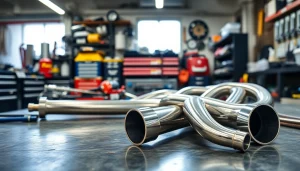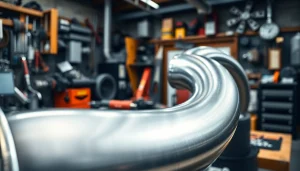Enhancing Your Production: The Definitive Guide to Precision Die Cutting
Understanding Precision Die Cutting
What is Precision Die Cutting?
Precision die cutting is a manufacturing process that involves cutting materials into specific shapes and sizes using a die, which is a specialized tool. This process employs various techniques to ensure high accuracy and repeatability, making it ideal for production runs where consistency in parts is critical. Precision die cutting is widely utilized across multiple industries, including automotive, electronics, packaging, and medical sectors, where exact specifications must be met to ensure product quality and functionality. For companies looking to integrate this technology into their workflow, understanding the nuances of precision die cutting can facilitate improved production outcomes.
Benefits of Precision Die Cutting in Manufacturing
The precision die cutting process offers numerous benefits that contribute significantly to the efficiency and quality of manufacturing operations. The primary advantages include:
- High Accuracy: Precision die cutting ensures parts are cut to exact specifications, reducing discrepancies and ensuring compatibility with assembly processes.
- Cost-Effectiveness: When producing large quantities, the cost per unit decreases significantly due to reduced manual input and the efficiency of automated processes.
- Versatility: This method can be applied to various materials, including paper, plastic, rubber, foam, and metals, making it suitable for diverse applications.
- Reduced Waste: Die cutting optimally utilizes raw materials, minimizing scrap and contributing to more sustainable manufacturing practices.
- Short Turnaround Times: The speed of the die cutting process allows manufacturers to meet tight deadlines and quickly adjust to market demands.
Applications Across Industries
Precision die cutting is utilized in a multitude of industries, showcasing its adaptability and importance in modern manufacturing:
- Automotive: Used for cutting gaskets, seals, and interior components, precision die cutting ensures parts fit perfectly within the intricate systems of vehicles.
- Medical: In the medical field, precision die cutting produces sterile packaging materials, surgical instruments, and other critical components where precision and cleanliness are paramount.
- Electronics: Precision fabricated parts such as casings, insulators, andPCB components play a crucial role in the performance of electronic devices.
- Packaging: Efficient packaging solutions, including custom boxes and inserts, are created using precision die cutting to optimize space and enhance product presentation.
- Textiles: Applicability in cutting fabrics and other textile materials allows for the production of apparel, upholstery, and other fabric-based products.
Key Techniques in Precision Die Cutting
Flatbed vs. Rotary Die Cutting Methods
Die cutting can generally be categorized into two primary methods: flatbed die cutting and rotary die cutting, each possessing unique advantages.
- Flatbed Die Cutting: This method utilizes a hydraulic press that pushes the die down onto the material laid flat. Flatbed die cutting is particularly effective for thick materials and complex designs, offering high precision especially in small to medium production runs. It’s commonly used for applications where detailed cuts and intricate shapes are required.
- Rotary Die Cutting: In this process, a cylindrical die cuts the material as it moves on a continuous roll. Rotary die cutting is highly efficient for high-speed production and optimal for large quantities. This technique allows for rapid production with consistent accuracy and minimal waste, making it ideal for industries that require fast turnaround times, such as packaging.
Innovations in Die Cutting Technology
The field of precision die cutting is continuously evolving, with advancements in technology enhancing capabilities and efficiency:
- Laser Die Cutting: This method employs lasers to cut materials with extreme precision. Laser die cutting eliminates the need for physical dies, making it a flexible option for prototyping and custom designs.
- Digital Die Cutting: Digital cutting machines utilize computer-aided design (CAD) software to create cuts, allowing for rapid changes to designs without significant downtime.
- Robotic Automation: The integration of robots into die cutting processes offers improved speed and accuracy, reducing manual handling and minimizing the risk of human error.
Choosing the Right Die Cutting Process for Your Project
Determining the most suitable die cutting method for a particular project involves evaluating several factors, including:
- Material Type: Consider the thickness, flexibility, and durability of the material to ensure compatibility with the die cutting method.
- Production Volume: Assess whether the production run is small, medium, or large. Flatbed die cutting may be more appropriate for smaller runs, while rotary die cutting suits larger volumes.
- Complexity of Design: Intricate designs with fine details may benefit from the high precision of flatbed die cutting, while simpler designs may be efficiently handled by rotary die cutting.
- Cost Considerations: Evaluate the cost implications of tooling, production speeds, and material waste for each method to make an informed decision.
Material Considerations in Precision Die Cutting
Common Materials Used in Die Cutting
The choice of materials in precision die cutting significantly affects the outcome of the manufacturing process. Some commonly used materials include:
- Paper and Cardboard: Ideal for packaging and prototyping, these materials are easy to cut and shape, providing a clean finish.
- Plastic: Various types of plastic, such as polyethylene and polypropylene, are often used for producing durable parts and packaging solutions.
- Foam: Soft materials used for cushioning and insulation, foam die cutting provides excellent protection during shipping.
- Rubber: Commonly used for gaskets and seals, rubber die cutting ensures resilience and flexibility in challenging environments.
- Metals: Thin sheets of metal can also be die-cut for parts requiring additional strength, such as in automotive and electronics applications.
Impact of Material Type on Precision and Cost
The type of material selected for die cutting not only influences the precision of the cut but also the overall cost of production:
- Precision Level: Materials such as paper and thin plastics are generally easier to cut with high precision compared to thicker or denser materials.
- Material Waste: Softer materials can be cut with less waste; however, harder materials may result in more scrap due to chipping or improper cutting.
- Tooling Costs: Some materials may require specialized dies, increasing initial capital investment but potentially lowering operational costs with higher efficiency.
How to Select the Best Material for Your Application
Selecting the right material involves assessing the application requirements and product design. Key considerations include:
- Application Environment: Determine whether the part will face exposure to chemicals, heat, moisture, or mechanical stress.
- Budget Constraints: Balance quality and cost-effectiveness, especially for larger production runs.
- Regulatory Compliance: Ensure selected materials meet any relevant industry standards, particularly in sectors such as medical and food packaging.
Optimizing Die Cutting for Efficiency
Setting Up for High-Volume Precision Die Cutting
For manufacturers aiming for high volumes of precision die cutting, an effective setup is vital. Key steps include:
- Process Design: Streamline the die cutting workflow through automation and integrated systems that enhance productivity.
- Employee Training: Train operators on the machinery to ensure optimal use and minimize errors during the cutting process.
- Maintenance Schedule: Regular maintenance of dies and cutting machines prevents downtime and maintains production quality.
Quality Control and Assurance Practices
Establishing a robust quality control mechanism is essential in precision die cutting. Consider implementing the following practices:
- Regular Inspections: Conduct routine inspections of both the machinery and the finished products to catch discrepancies early.
- Statistical Process Control (SPC): Use data-driven techniques to monitor and control the die cutting processes for consistency and quality.
- Calibration: Regularly calibrate equipment to maintain the integrity of the cutting processes.
Reducing Waste in the Die Cutting Process
An effective strategy for minimizing waste in die cutting can significantly enhance profitability:
- Smart Layout Planning: Utilize software to create efficient layouts that maximize material usage while minimizing scrap.
- Recycling Scrap Material: Consider ways to recycle or repurpose scrap materials, thereby reducing disposal costs and contributing to sustainability initiatives.
- Just-in-Time Manufacturing: Implement a just-in-time strategy to align production schedules with customer demand, reducing material waste from overproduction.
Future Trends in Precision Die Cutting
Emerging Technologies and Techniques
The landscape of precision die cutting is rapidly changing with the proliferation of new technologies:
- Artificial Intelligence: The integration of AI in production processes can enhance quality control, predictive maintenance, and operational efficiency.
- 3D Printing Integration: As 3D printing technology evolves, combining it with die cutting processes can open new avenues for creating complex designs and rapid prototyping.
Customer Demand and Customization Opportunities
Today’s consumers are increasingly drawn to customized products tailored to their needs. To meet this demand, manufacturers should consider:
- Flexible Production Lines: Investing in technologies that allow for quick shifts in production allows businesses to respond swiftly to market changes.
- Collaborative Design Approaches: Working closely with customers to understand their unique requirements can foster loyalty and long-term partnerships.
Environmental Sustainability in Die Cutting
As industries shift towards sustainable practices, so too must die cutting processes evolve:
- Eco-Friendly Materials: Using biodegradable or recyclable materials can significantly minimize the environmental impact of die-cut products.
- Energy-Efficient Equipment: Upgrading to energy-efficient machinery reduces operational costs while contributing to overall sustainability.
- Sustainable Waste Management: Implementing strategies for wastewater treatment and recycling can further bolster a company’s green initiatives.







